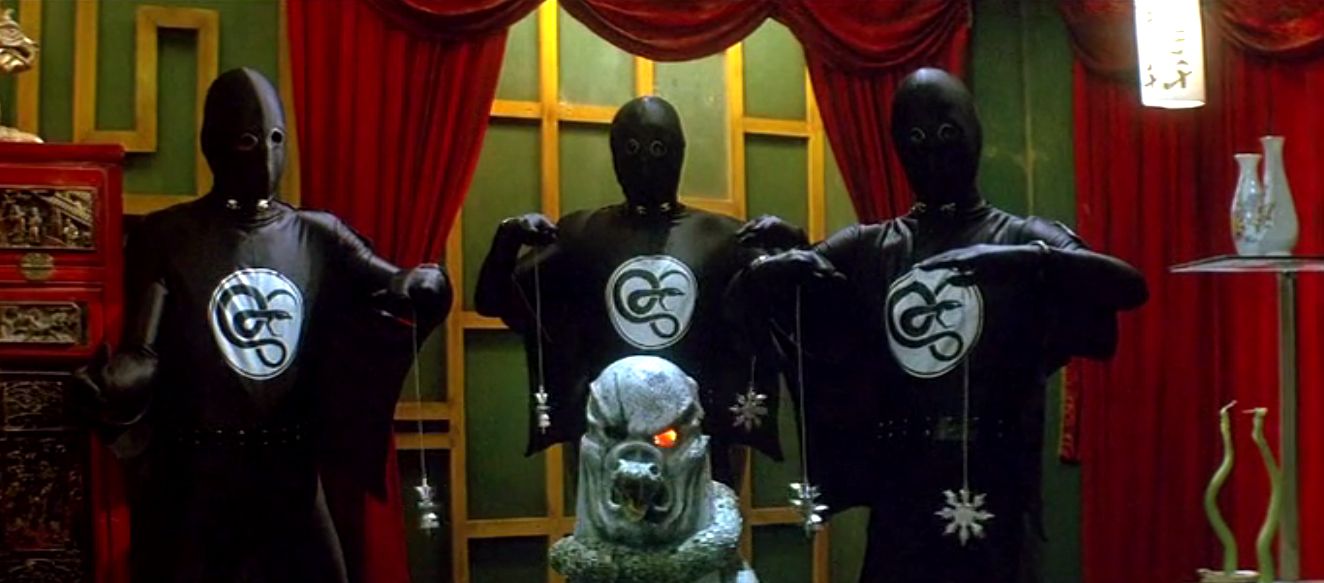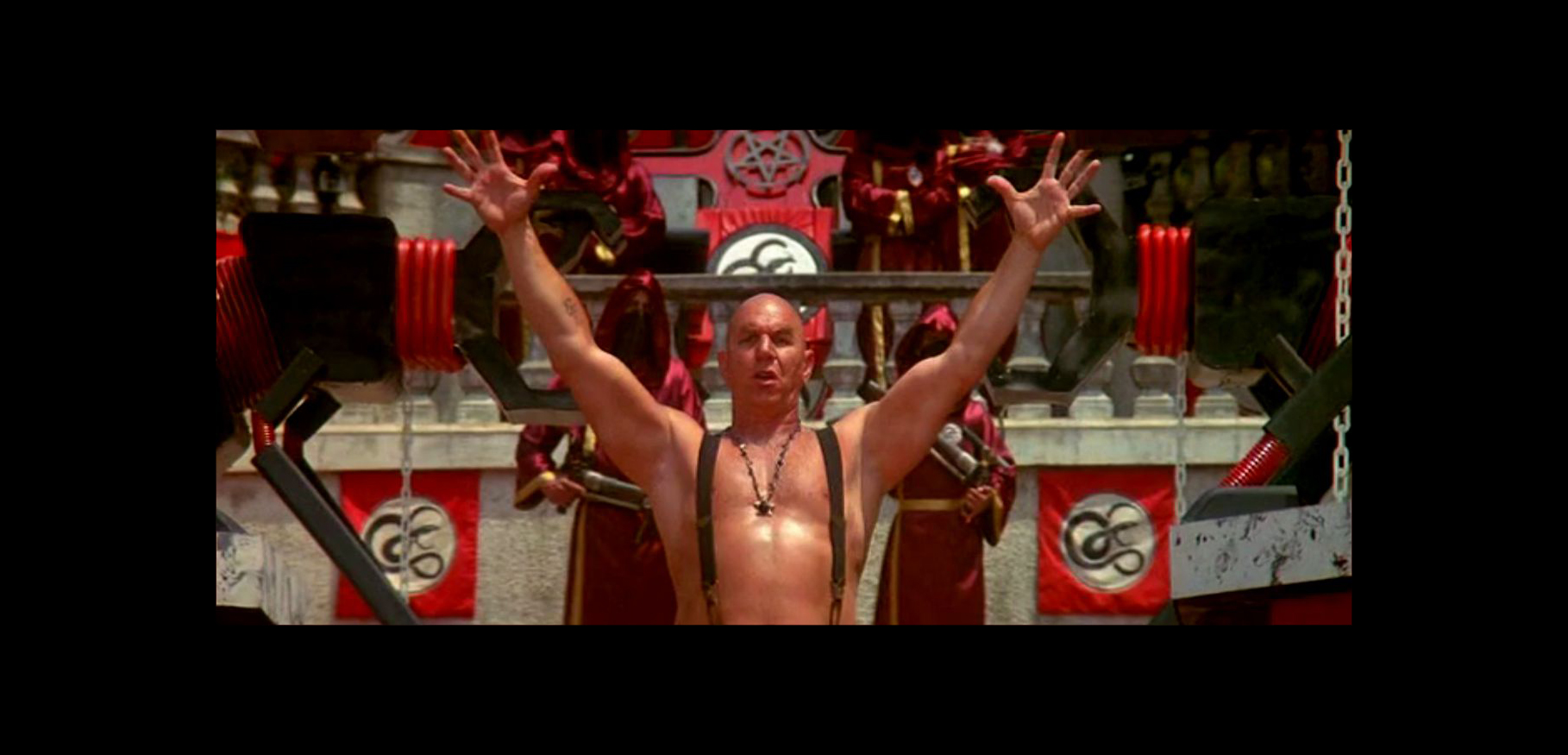“We have a gorilla suit, let’s use it.” – Jim Wynorski, Director
“The Lost Empire” might be the rare film where you want to watch it with the director’s audio commentary turned on before actually watching the film itself. Before getting into details regarding the film though, let me first offer a personal anecdote regarding my relationship with this guilty pleasure of a movie:
“The Lost Empire” had long been the film-equivalent of a ‘white whale’ that I had been actively chasing for at least five years, if not longer. I first saw the film as a child in the mid-1980s, during the kind of summer Saturday evening when my extended family would gather for ‘movie rental night’ viewing parties. In looking at the IMDB description for “The Lost Empire,” one might why some of the film’s imagery stuck in my head for several decades (I added the emphasis):
“After officer Rob Wolfe is killed trying to stop a gang of ninjas from robbing a jewelry store, his sister, officer Angel Wolfe, vows to avenge his death. Her investigation leads her to the mysterious Dr. Sin Do, who is supposedly in league with an undead wizard named Lee Chuck. The doctor is holding a martial arts tournament on a secret island fortress, so Angel, after rounding up some of her martial-artist friends, enters the tournament in the hopes of finding Sin Do and Lee Chuck and bringing them to justice.”
It should also be said that Angel’s friends/allies included a visually bizarre Native American mystic known as ‘White Star’ and a woman skilled at mud fighting in prison.
To paraphrase “Jerry Maguire” – ‘You had me at ninjas.’

Yes, this was a film actually created in our reality around 1985. Although, I’ve seen it listed as having been released anywhere from 1983 to as late as 1986.
I remembered the gorilla suit but could not have otherwise told you what it had to do with anything in the story. Left unsaid was that the bad guys had a cultish secret society going on that used quasi-Nazi imagery in their banners and logo design.
Keep in mind that I was way too young to be watching this kind of a film as a child and recalled having to ‘cover my eyes’ for probably half its runtime (be it for nudity, violence, etc.). So far as I could trace things, “The Lost Empire” was perhaps my first introduction to exploitation films. That said, I could not say who was being exploited the most… Women? Native Americans? Nazis? Ninjas? Gorillas? Me the viewer? One can’t help be but left breathless by the tantalizing trash of it all.
After originally seeing the film, I couldn’t remember the name of it years later when it again came to mind. I vaguely recalled the word ’empire’ in the title and remembered ninja thieves, women fighting, and a weird Nazi-like cult that operated out of a hidden location. Given the mish-mash of everything in the film though, it was difficult to track down. I would spend a bit of time searching over the years when I’d think of it, more than anything frustrated that I simply couldn’t identify this artifact of my film-viewing youth. Hence, it became the aforementioned ‘white whale’ of my video hunting life.
I happened to think to search for the film again in mid-2014 after watching a documentary about forgotten VHS film releases entitled “Rewind This.” This time, I actually found it.
Why was my search suddenly successful after being dashed many times in the past? “The Lost Empire” had been released on DVD in April 2014, marking its first time appearing on the digital format.
Intriguingly, this release included an audio commentary from director Jim Wynorski. This was apparently his first film and he would go on to make 90+ low-budget films over the next thirty years. Wynorski somehow directed an average of three features per year. I can’t say that his filmography contained a number of ‘classics,’ but his follow-up to “The Lost Empire” was the semi-notable “Chopping Mall.” That was an entertaining 1986 low-budget teen horror film involving a robot security gone amuck in a mall.
It took over a month for the DVD of “The Lost Empire” to arrive after I initially placed my order, creating an odd anticipation within me that I’ve rarely experienced any longer in our modern on-demand culture. I’m not sure what the issue was that delayed product shipment, but perhaps the film had been selling better than expected and there were supply problems.
Upon viewing “The Lost Empire” on DVD, I confirmed that the plot was as convoluted as the IMDB description indicated. It could be boiled down to a simple revenge tale though: Supercop Angel Wolfe’s police officer brother was killed by a ninja cult. She traced the ninjas back to their secret island compound where the cult-like group held a martial arts tournament. Angel and two of her friends took advantage of the opportunity to compete in the tournament and sought payback along the way.
Part of a general comprehension problem with the film might stem from the fact that the opening “Star Wars”-esque text crawl scrolled past at a ridiculously fast pace. A full mythology regarding the ninja cult was presented in several paragraphs but it was too hard to digest when flying by so quickly, a fact conceded by Wynorski on the DVD’s audio commentary.
Also mentioned by Wynorski was the film somehow having been shot in only sixteen days. That seemed incredibly aggressive given the diversity of locations. There were location shoots involved at a business in downtown Los Angles, the Burbank Airport, a hospital, several private residences, and Bronson Caves in Hollywood. That didn’t even account for extensive sound stage work.
In some films, special effects work might slow down progress. That would not appear to have been the case with “The Lost Empire.” The effects were the result of a mix of stock footage from 1960s Twentieth Century Fox sources and inserts of obvious matte paintings.
A further example of the film’s tight budget involved Wynorski’s frequent references to not wanting to pay extras the mandated $398.00 for a speaking part. As a result, ‘creative’ workarounds were made to avoid overpaying on extras. One instance of this approach occurred when Angel learned that her brother had died via two silent police officers looking down after she asked them for an update on her brother’s condition.
While the film did focus on showing girls in skimpy outfits and there was nudity, the filmmakers genuinely did seem to be trying to make something more than a 1980s ‘skin flick.’ It should be pointed out that the film’s lead, Melanie Vincz, refused to appear naked on camera but Wynorski still cast her. He said that he wanted a decent actress in the lead role and that was a good decision.
To elaborate on the outfits though: Nearly every piece of clothing worn by the female leads was ridiculous in almost any context. Wynorski suggested that the film was pitched as “‘Charlie’s Angels’ meets ‘Enter the Dragon’” and one might assume that the clothing choices were somewhat of a nod to the Angels.
Especially during the more-pedestrian scenes early in the film though, it made no sense for Angel and her friends to dress like they did unless they wanted to draw attention upon themselves. Such attention would seem like a bad idea if one were trying to investigative a crime. The costumes of the leads were also changed frequently from scene to scene, leading to a strange sort of period fashion show as the film progressed.
Robert Tessier, whose exaggerated eyebrows fluctuated in size from scene to scene, played the cult leader’s henchman and film’s main ‘heavy.’ To hear Wynorski tell it, Tessier wasn’t very easy to work with and seemed like a legitimate character of a person. Tessier had an intimidating presence and, amongst others, participated in the film’s ‘tournament’ scenes. Of course, those expecting a competition on par with “Enter the Dragon” would be let down.
Angel’s boyfriend spent much of the film playing catch-up with the women while supplying an odd mix of comic relief and traditional macho heroics. After being left behind midway through the film, he unexpectedly arrived on the cult’s secret island (in a wet suit and scuba equipment no less) and played a helpful role in stopping the bad guys.
Based on Wynorski’s comments throughout the film, it seemed like many of those involved in the production were his friends or longtime associates. Raven De La Croix, who played the Native American mystic ‘Whitestar’ was apparently Wynorski’s girlfriend around the time of filming. Despite (or due to?) this relationship, Wynorski had no problem with prominently featuring De La Croix naked during the film’s climax. John Carpenter’s frequent scoring collaborator Alan Hayworth provided the score for the film.
While the film wasn’t a Roger Corman production, Corman’s fingerprints were somewhat on the film due to his past association with Wynorski and the use of Corman’s soundstages/sets in the filming.
Tracking the film’s distribution history, “The Lost Empire” appeared to have originally been released on VHS cassette tape via Vestron Video’s Lightning Video genre label. The film was largely ignored for nearly 30 years until the 2014 DVD release, which included some level of re-mastering for what ended up being a decent presentation. It was nice to see the film’s in its original widescreen picture ratio.
Wynorski admitted that he assumed that he might never again direct a film after “The Lost Empire.” As a result, he included every quirky idea that he might ever want to do in a movie. Part of the film’s charm was the ridiculous ‘mash-up’ feel that resulted from Wynorski achieving that goal. Truly, “The Lost Empire” was not a good film but it would likely win bonus points from many viewers simply for what it aspired to be.
- Moonlighting (1985) – A Series Review - September 12, 2024
- San Diego Comic-Con 2024 Analysis - July 31, 2024
- “Masters of Doom” by David Kushner - December 16, 2023

One thought on “Re-Discovering The Lost Empire (1985) with Jim Wynorski”
I just watched this on Amazon Prime, right up until the prison scene, it was suddenly the best film i’ve ever seen. But that tightrope couldn’t be walked for long. It’s still pretty entertaining, but for me, it goes downhill after the mudfight.